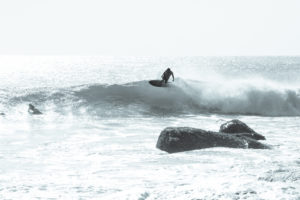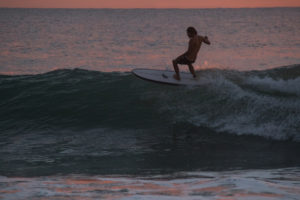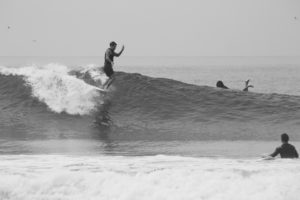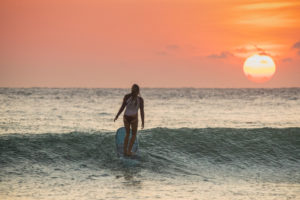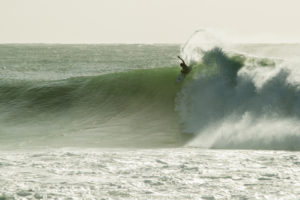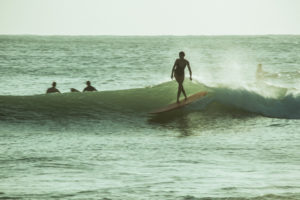[sam_pro id=”1_45″ codes=”true”]

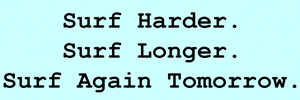

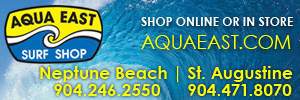
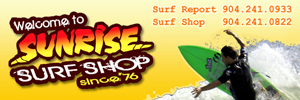




Glenn T Goodwin, PhD, DABFE
Film review from magicseaweed
There’s a feeling within our sport that can help lay the foundation for natural connections. Your relation to the sea and self, your awareness of friendships and relationships in the water, seeking empty lineups, stoke from that next wave, these are all elements that contribute towards our shared experience.
And it’s why Nathan Oldfield’s The Church of the Open Sky is a must watch. Not only does it explore the relationship between surfer and sea and is stunningly shot, but it also peels back the veneer of a squeaky clean surf lifestyle through provocative monologues – focusing on plights and troubles that afflict surfers.
Addiction, loss, war, natural disasters are all raw subjects that are touched upon as this documentary plays out. But so too is that feeling of pure unfiltered stoke (see children surfing wooden boards in Papua New Guinea), and it all cycles back to how surfing has a powerful impact on our lives, how dancing over a wave face can be a curative for emotional and psychological afflictions – and yet so much more.
We caught up with Nathan to talk about the film’s premise, its scope, those powerful messages and holding down a job as a teacher while creating surf movies.
(Q) Tell us a bit about the premise of the film.
The film’s called The Church of the Open Sky, which is a paraphrase of a Tom Blake saying, where he referred to surfing as worshipping in ‘the blessed church of the open sky.’
That phrase always stuck with me over the years. I like the idea of surfing as ‘Church’ because for me surfing is much deeper than a physical activity. I’ve always felt that surfing is an internal, metaphysical experience. ‘Everything is sacred,’ wrote Tierre de Chardin.
That is something that I’ve always felt most deeply when I have been in the sea. So I also like the idea of surfing being a kind of gathering, like a church, a kind of fellowship.
And another thing I appreciate is the idea of a non-denominational church, under the open sky, where everyone is welcome, where nobody is excluded. The movie doesn’t explore these ideas explicitly, but they are themes that subtly run through the work.
I think that people who are familiar with my previous films will feel that this one isn’t too much of a departure from how I’ve made them in the past. It is a combination of simple stories about surfing lives, interspersed with purely surf soaked sequences. I guess in its essence the film is a documentary. I like to be a fly on the wall and to film people’s genuine experiences of life and travel and personal growth and relationships and, of course, surfing
I never actually have a storyboard, or even a strong sense of a film’s direction, until I start making it in the first place. I like to plan a trip or to plan a shoot with a surfer and to see where life takes us. It’s very organic for me. I like to be as uncontrived as possible. Just to film the moments as they actually unfold rather than have a preconceived idea and conform the narrative of the film to that. So, really, I like to be a fly on the wall and to film people’s genuine experiences of life and travel and personal growth and relationships and, of course, surfing.
(Q) Who’s in the film and where is it shot?
The film is shot in Australia, New Zealand, Papua New Guinea and Sri Lanka. Many of the surfers in the film are close friends of mine, and some of them have featured in several of my films over a lot of years. It features Dave Rastovich, Lauren Lindsey Hill, Tom Wegener, Belinda Baggs, CJ Nelson, Alex Knost, Johnny Abegg, Neal Purchase Jr, Jasson Salisbury, Devon Howard and many others.
(Q) How long did it take to shoot?
It took just over two-and-a-half years to make, beginning to end. It always takes me a while to make my movies. I’m actually a school teacher who makes films on the side, because although I’ve been doing it for over 15-years, I’ve never been able to make a living from surf films.
So in that sense my working hours are limited. I’m also a father of three kids so I am pretty busy in the family department, too, which is obviously my main priority in life. And on top of all that I know that I’m a perfectionist who likes to get things just right. So I tend to make things slowly and carefully.
(Q) The Church of the Open Sky touches on some hard hitting issues. I won’t spoil too much but CJ Nelson’s account of addiction and loss was particularly moving. But the film also focuses on people who have faced racial abuse, war, tragedy and much more – and they all seem to find comfort in the ocean. Was that something you set about portraying?
It was a very organic kind of process. I never planned it, but I guess I gravitate to those kinds of transformative stories. I think those of us who have surfed for all of our lives have had the experience of surfing carrying us through the many seasons, light and dark, that life opens us up to. Surfing changes us. The sea holds us up. Surfing can be shelter and solace.
And in keeping with the ‘church’ thread that weaves through the film, the daily practice of surfing can be sacramental for a lot of us. These are themes that often keep emerging in my work, almost of their own volition.
(Q) How did it feel to shoot those incredibly raw monologues? Was it difficult for people to open up?
I think people will only open up if they feel like they can trust you to tell their story authentically and sensitively. To build that trust it takes relationship. I guess that’s why I tend to shoot with surfers who are friends. It’s always a privilege to be in the presence of someone sharing their heart. And I’m also aware of the huge responsibility I have as a documentary filmmaker to tell people’s stories with integrity.
(Q) There’s also the sharing of stoke and experience. Kind of juxtaposed to the aforementioned. There’s a good contrast of stories being told. Was that an aim of the film?
Yes, for sure. I always tend to make films with a balance of storytelling and then just straight up surfing. I’m still a stoked grommet really. I’m a long time surf movie aficionado who loves to watch good, clean, uninterrupted surfing. Plus it’s also a good way to give the audience respite after some of the more sober parts of the film. The pure surfing sequences provide some healthy breathing space in the film.
(Q) I guess a lot of it is open to interpretation. For me, it felt like this was a story about connections, in life, to each other…
Absolutely. For me the most important things in life is healthy relationships with family and friends. It seems natural to explore and celebrate human connectivity in surf films.
(Q) The film’s stunningly shot, let’s talk equipment. What did you use?
Thank you. I’m actually pretty low-fi equipment wise. People regularly assume I’m shooting 16mm or even 35mm. Then the other day I read a review of my work where the critic praised my use of RED cameras.
I had to chuckle, because I shoot with a couple of Canon DSLRs. I can’t afford to shoot film or to buy a RED. But in lots of ways I feel that equipment is secondary to the vision that you have as a filmmaker, and the heart and soul of the story that you are telling. As a filmmaker, I’m a bit of a one man band.
Sometimes I might have a friend to help me shoot the double angle, but most of the time it just me alternating between shooting from land and in the water. I like to collect as many angles as I can to give me room to move later when I’m editing. I’m actually an untrained, self-taught filmmaker, but I’ve been making photographs since I was a little kid, and making surf films for 15-years. I’ve developed my own sense for composition and light play and texture.
(Q) How did you select where to shoot? Bound by forecast or was the premise more focused around the story to tell?
Some trips I was invited on and others I planned. None of the trips were forecast driven. I just went and saw what happened. And none of the stories were scripted. Each part of the film literally blossomed in its own way. The stories just kind of revealed themselves to me on the journey.
(Q) Any difficulties in shooting at some of the more remote locations?
Just the usual stuff. Frying on the beach for hours in tropical heat, delirious and dehydrated. Being eaten alive by mosquitoes. Cameras overheating and shutting down. Shooting in the water all day until the blisters from the swim fins finally send you in.
Sea ulcers and tropical fevers from untreated wounds. Getting chased by elephants. But all of it is so worth it to me. I’m passionate about collecting good surfing images with good people. Apart from actually surfing myself, one of my favourite things to do is to shoot surfing.
(Q) What are your personal highlights?
Really, there were so many moments in making this film that are personal highlights. I’m especially thankful for all of the travel moments I shared with my family and friends while putting the film together. It’s so hard to pick just one moment but I’ll try.
Without giving too much away, while shooting the opening sequence of the film in remote Papua New Guinea, I saw some kids surfing in front of their village. They were just playing along a little patch of reef out along the edge of things, literally in the middle of nowhere, with bellyboards made from palm fronds and bits of scavenged driftwood and homemade rough shaped scraps of timber.
It was the most elemental surfing that I have ever personally seen. Just pure, natural, genuine play. It reminded me that surfing is so universal and simple and somehow so beautifully human. I had goosebumps and tears in my eyes while shooting. I felt enormously fortunate to have been there, and just so grateful to be able to document and share that kind of surfing in the film. My heart swells just thinking about it.
Check in with Nathan by going HERE. You can now buy the film by going HERE.
Hallelujah, keep your edge.
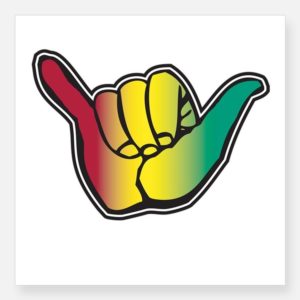
Watch the trailer…

